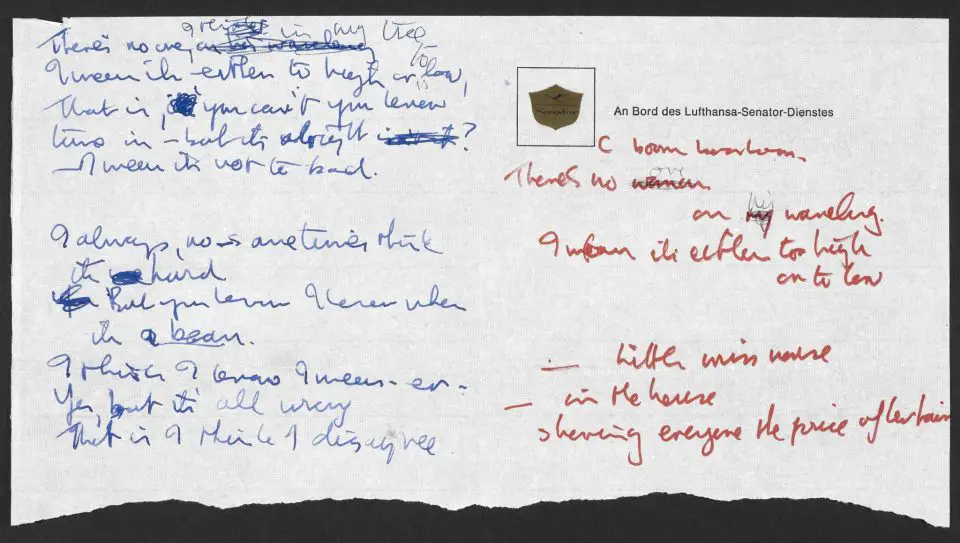One of The Beatles’ undisputed masterpieces, ‘Strawberry Fields Forever’ was written by John Lennon and first released on a single with ‘Penny Lane’.
‘Strawberry Fields’ was psychoanalysis set to music.
Anthology
Lennon wrote the song in Almería, Spain in autumn 1966, while filming his role as Private Gripweed in the Richard Lester movie How I Won The War.
Dick Lester offered me the part in this movie, which gave me time to think without going home. We were in Almería, and it took me six weeks to write the song. I was writing it all the time I was making the film. And as anybody knows about film work, there’s a lot of hanging around.
All We Are Saying, David Sheff
Like ‘Penny Lane’, ‘Strawberry Fields Forever’ was a nostalgic look back at The Beatles’ past in Liverpool. Strawberry Field was the name of a Salvation Army children’s home near John Lennon’s childhood home in Woolton.
I’ve seen Strawberry Field described as a dull, grimy place next door to him that John imagined to be a beautiful place, but in the summer it wasn’t dull and grimy at all: it was a secret garden. John’s memory of it wasn’t to do with the fact that it was a Salvation Army home; that was up at the house. There was a wall you could bunk over and it was a rather wild garden, it wasn’t manicured at all, so it was easy to hide in.
With his childhood friends Pete Shotton and Ivan Vaughan, Lennon would roam the grounds of Strawberry Field. Additionally, each summer there would be a garden party held in the grounds, which he especially looked forward to.
As soon as we could hear the Salvation Army band starting, John would jump up and down shouting, ‘Mimi, come on. We’re going to be late.’
The Beatles, Hunter Davies
Through the lens of LSD, however, the song song turned from simple nostalgia into inward reflection. Lennon’s self doubt came to the fore, at times clouded by inarticulacy and hallucinogenic sensations.
He later described ‘Strawberry Fields Forever’, along with ‘Help!’, as “one of the few true songs I ever wrote… They were the ones I really wrote from experience and not projecting myself into a situation and writing a nice story about it.”
The second line [sic] goes, ‘No one I think is in my tree.’ Well, what I was trying to say in that line is ‘Nobody seems to be as hip as me, therefore I must be crazy or a genius.’ It’s the same problem as I had when I was five: ‘There is something wrong with me because I seem to see things other people don’t see. Am I crazy, or am I a genius?’ … What I’m saying, in my insecure way, is ‘Nobody seems to understand where I’m coming from. I seem to see things in a different way from most people.’
All We Are Saying, David Sheff
The music
Freed from the constraints of touring, in the latter months of 1966 The Beatles began a series of open-ended sessions at Abbey Road, with little regard to time and budget.
Although it was to end up as a psychedelic masterpiece, ‘Strawberry Fields Forever’ began relatively simply. John Lennon recorded a series of solo demos in mid-November 1966 at his home in Weybridge, Surrey.
A sequence from the recordings was included on Anthology 2. In it, Lennon begins by fingerpicking the individual notes of the chords, before breaking off and muttering, “I cannae do it.” He begins again, strumming the guitar and singing.
Instead of opening with the chorus, the early versions of the song began with the first two verses back-to-back. This initial arrangement was also used on take one in the studio, also available on Anthology 2. This first take also has a rounded ending; a Mellotron and guitar instrumental passage, in stark contrast to the psychedelic spectacle of the final version.
The Mellotron was a fairly new keyboard instrument in 1966, which The Moody Blues’ Mike Pinder had introduced The Beatles to in 1965.
I got to know John, Paul, George and Ringo over the years and I introduced them to the ‘tron… Within a week all four of them had a Fab-Tron. I knew that I would be rewarded, and the first time I heard ‘Strawberry Fields’ I was in bliss. It was the closest thing to recording with them, other than my visits to Abbey Road during their recording sessions.
The instrument had a bank of magnetic audio tapes inside, each lasting approximately eight seconds and containing a range of pre-recorded sounds. These tape loops could be used to mimic other instruments; The Beatles used the flute sound for the introduction to ‘Strawberry Fields Forever’.
I remember when The Beatles first brought in the Mellotron. It was made mostly for producing sound effects but it also had flutes, brass and string sounds on it. The Beatles used it in a way nobody had ever thought of.
The Complete Beatles Recording Sessions, Mark Lewisohn



Please could you correct the list of musicians? The ‘cellist listed as John Hall is in fact Joy Hall, a member of the Delmé String Quartet that also included Jürgen Hess and John Underwood both of whom recorded on Beatles tracks.
Thanks,
John